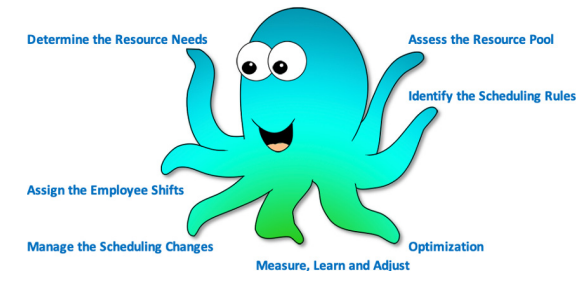Resource Planning
(Scheduling)
An hour/day in the life of the Resource Planners is not just about answering the phone and assigning shifts based on availabilities. There is a lot that goes on behind the scenes, so let’s look at the bigger picture.
If you asked someone “what does a scheduler do?” the most common response would be “they schedule” I’ll bet, you didn’t know that there are 7 basic components to managing a successful workforce schedule.
In my own personal career, I have many years of production, manpower, fleet and project planning and scheduling. One thing that is definite in the world of resource planning and scheduling is that you are “always-on”
Life as a resource planner and scheduler without a doubt can get complicated, hectic, and yet the most satisfying and rewarding thing you can do.
If you were to ask me to give you a high-level definition or summary, my response would be “it’s like an octopus with tentacles reaching out to every sector of the business”.
Before we get into the 7 arms of resource planning let’s look at the complexities revolving in and around scheduling.
Recruitment, Human Resources, Labour Relations, Training, Payroll and of course Operations. All separate departments within the business but, all associated to resource planning in one way or another.

So, what are the 7 components that drives the planner/scheduler
- Mapping needs by roles and locations
- Identify historical trends
- Define required qualifications
2. Assess the Resource Pool
- Planning ahead
- Analyzing and allocating resources
- Include all resources in the schedule equally
3. Identify the Scheduling Rules
- Training and certifications
- Compliance to Safety, employment, and Labour Laws
4. Assigning the Employee Shifts
- Qualifications and Experience
- Changes to employee availabilities
- Availabilities and Preferences
5. Managing the Schedule Changes
- Demand swings and changing requirements
- Changes to employee availabilities
6. Measure Learn and Adjust
- Forecasting accuracy
- Evaluate resources
- Scheduling process
- Analytics, Reporting and Scheduling
7. Optimization
- Identify the priorities and formulate a plan
- Increase efficiency, minimize costs and reduce waste
- Balance the schedule with experience and knowledge
- Reassess the plan and execute
And then … there is the unexpected, the challenge of managing the “change-up
- Unplanned client/contractor requests and cancellations
- Employee vacations, book-offs, no-shows, recurrent training, and employee upgrades
- Scheduling during COVID
So, the next time you see Justin and Aman, remember their role is not as simple as it looks and let them know they are appreciated for everything they do!

